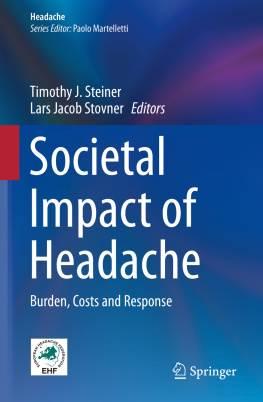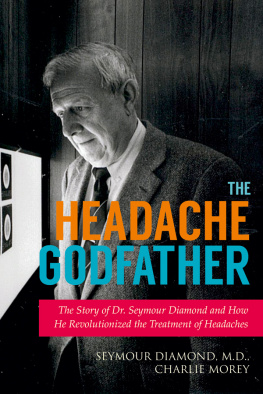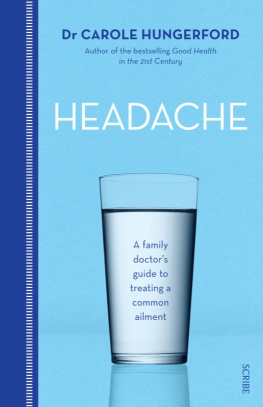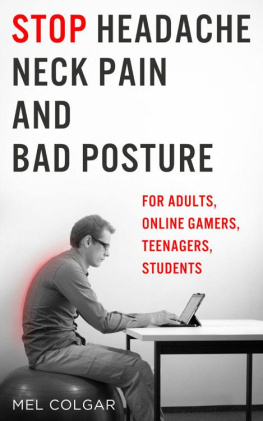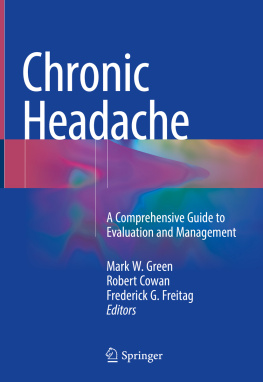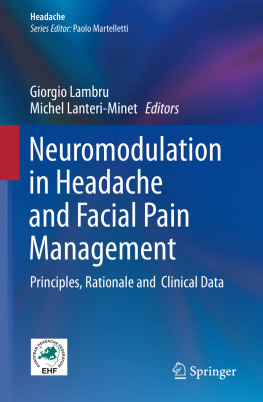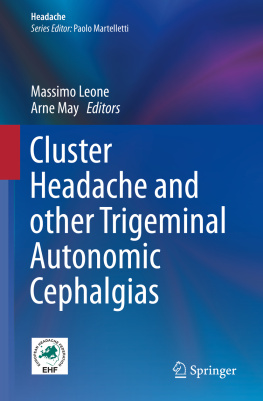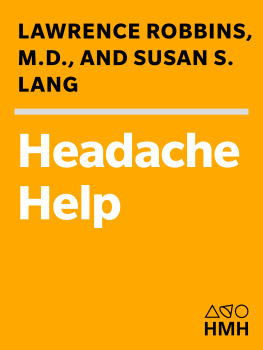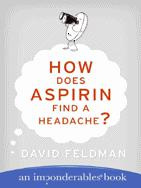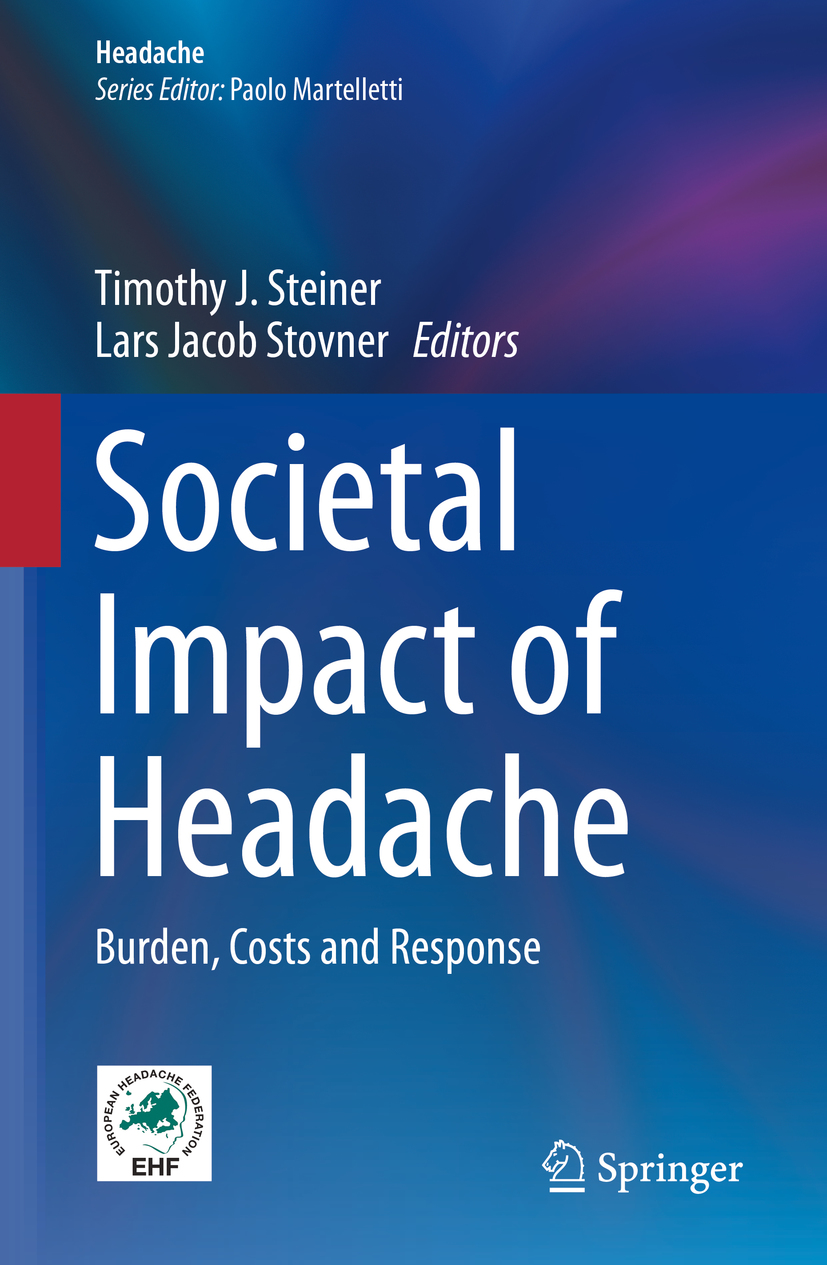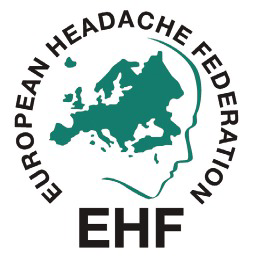Headache
Series Editor
Paolo Martelletti
Roma, Italy
The purpose of this Series, endorsed by the European Headache Federation (EHF), is to describe in detail all aspects of headache disorders that are of importance in primary care and the hospital setting, including pathophysiology, diagnosis, management, comorbidities, and issues in particular patient groups. A key feature of the Series is its multidisciplinary approach, and it will have wide appeal to internists, rheumatologists, neurologists, pain doctors, general practitioners, primary care givers, and pediatricians. Readers will find that the Series assists not only in understanding, recognizing, and treating the primary headache disorders, but also in identifying the potentially dangerous underlying causes of secondary headache disorders and avoiding mismanagement and overuse of medications for acute headache, which are major risk factors for disease aggravation. Each volume is designed to meet the needs of both more experienced professionals and medical students, residents, and trainees.
More information about this series at http://www.springer.com/series/11801
Editors
Timothy J. Steiner
Department of Neuromedicine and Movement Science, NTNU Norwegian University of Science and Technology, Trondheim, Norway
Division of Brain Sciences, Imperial College London, London, UK
Lars Jacob Stovner
Department of Neuromedicine and Movement Science, NTNU Norwegian University of Science and Technology, Trondheim, Norway
Norwegian Advisory Unit on Headaches, Department of Neurology and Clinical Neurophysiology, St Olavs University Hospital, Trondheim, Norway
ISSN 2197-652X e-ISSN 2197-6538
Headache
ISBN 978-3-030-24726-3 e-ISBN 978-3-030-24728-7
https://doi.org/10.1007/978-3-030-24728-7
Springer Nature Switzerland AG 2019
This work is subject to copyright. All rights are reserved by the Publisher, whether the whole or part of the material is concerned, specifically the rights of translation, reprinting, reuse of illustrations, recitation, broadcasting, reproduction on microfilms or in any other physical way, and transmission or information storage and retrieval, electronic adaptation, computer software, or by similar or dissimilar methodology now known or hereafter developed.
The use of general descriptive names, registered names, trademarks, service marks, etc. in this publication does not imply, even in the absence of a specific statement, that such names are exempt from the relevant protective laws and regulations and therefore free for general use.
The publisher, the authors, and the editors are safe to assume that the advice and information in this book are believed to be true and accurate at the date of publication. Neither the publisher nor the authors or the editors give a warranty, expressed or implied, with respect to the material contained herein or for any errors or omissions that may have been made. The publisher remains neutral with regard to jurisdictional claims in published maps and institutional affiliations.
This Springer imprint is published by the registered company Springer Nature Switzerland AG
The registered company address is: Gewerbestrasse 11, 6330 Cham, Switzerland
Foreword
Headache disorders are ubiquitous, highly prevalent and disabling. In the Global Burden of Disease Study 2010, tension-type headache and migraine were recognized as the second and third most prevalent disorders in the world. Headache is experienced by nearly everybody at some time or times in their lives. At any one time, at least 40% of the worlds adults have personal experience of one or more headache disorders, while recent surveys suggest the proportion of adults with headache on any particular day exceeds 1 in 20. In the Global Burden of Disease Study 2016, migraine was ranked as the second highest cause of disability overall and first in young adults (aged 1549 years).
The high prevalence of headache disorders gives rise to ill health and disability on a very substantial scale, which is being increasingly acknowledged. This monograph considers the public health perspective, and societal impact, of these conditions. While our understanding of the global burden attributable to headache disorders is still incomplete and our knowledge of healthcare resource allocation to headache is scant, there is good evidence to indicate that very large numbers of people disabled by headache do not receive effective healthcare. The barriers responsible for this vary throughout the world, but poor awareness in a context of limited resources generallyand for healthcare in particularis undoubtedly high among them.
The World Health Organizations
Atlas of Headache Disorders and Resources in the World 2011 had this message for health planners and policy-makers:
The facts and figures presented [in the Atlas ] illuminate the worldwide neglect of a major cause of public ill-health and reveal the inadequacies of responses to it in countries throughout the world.
Moreover:
Given the very high indirect costs of headache, greater investment in health care that treats headache effectively, through well-organized health services and supported by education, may well be cost-saving overall.
This, therefore, is a monograph not so much about headache, or headache disorders, but rather about public health. In particular, the book provides a detailed analysis of the epidemiological and socioeconomic consequences of headache disorders, together with proposed and ongoing institutional and societal responses over the life course and across health and other sectors.
Dan Chisholm
Abbreviations
BASH
British Association for the Study of Headache
BMI
Body mass index
CATI
Computer-assisted telephone interview
CG
Condition group (in ICF)
CH
Cluster headache
CI
Confidence interval
CM
Chronic migraine
CMSCs
Chronic musculoskeletal complaints
COI
Cost of illness
CSF
Cerebrospinal fluid
CT
Computer tomography
DALY
Disability-adjusted life year
DW
Disability weight (applied to a health state in GBD)
EBC
European Brain Council
EC
European Commission
EEM
Equal effects model
EHF
European Headache Federation
EM
Episodic migraine
ENT
Ear, nose and throat
ERB
Ethics review board
EU
European Union
GBD
Global Burden of Disease (study)
GCA
Giant cell arteritis
GDP
Gross domestic product
GP
General (medical) practitioner
GPAC
Global Patient Advocacy Coalition
HADS
Hospital Anxiety and Depression Scale
HALT
Headache-attributed lost time (index)
HARDSHIP
Headache-attributed restriction, disability, social handicap and impaired participation (questionnaire)
HCP
Healthcare provider
HOH
Headache on the (Capitol) Hill
HUNT

